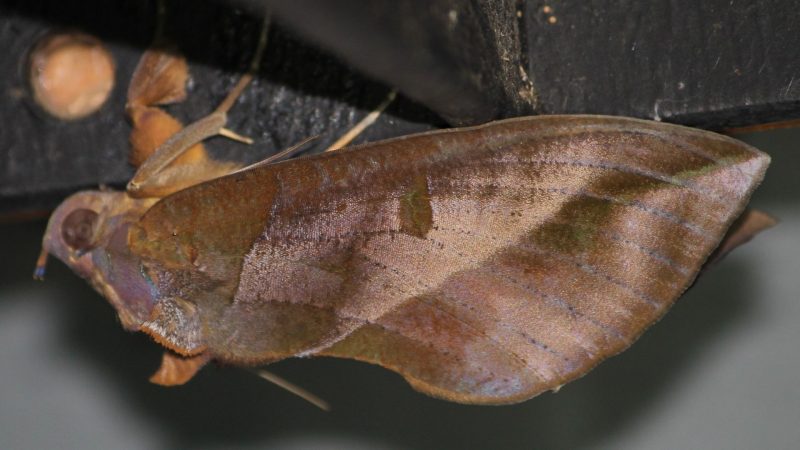There are thousands of different species of moths, and some people may be surprised to learn that there are moths that feed on the blood of vertebrates, including humans. These blood-sucking moths are called vampire moths.
What happens if you get bit by a vampire moth? Vampire moths can and will bite humans. They have a proboscis, a straw-like projection on their mouth that allows them to pierce and penetrate human skin, piercing it back and forth until blood is accessible. Their bite will cause slight pain, redness, and soreness around the wound.
It is true that there are moths that bite and suck blood from humans. But the question is, “Is there anything to be afraid of?”
What Are Vampire Moths?

The vampire moth, also known as “Calyptra thalictri” belongs to the genus Calyptra, a family of moths in the subfamily Calpinae of the Erebidae family. Vampire moths primarily feed on fruit juice and nectars. They use their proboscis to penetrate fruit skin and suck fruit juice.
Only male vampire moths are known to suck blood from vertebrates. Male vampire moths drink blood for salt or sodium content, which is transferred to the female vampire moths through sperm during mating, which is said to be beneficial for their offspring.
What Do Vampire Moths Look Like?
Vampire moths can be found in a variety of different genus, which causes some variation in their appearance. They typically resemble a single coin in size and are light yellow to grayish in color.
A typical sight throughout Asia and Eastern Europe are black vampire moths. The two huge wings of these moths, which have different camouflage designs, have a total of six legs.
Where Do Vampire Moths Live?

The first vampire moth was discovered in Siberia, and studies show that vampire moths have been found throughout Central and Southern Europe. They are also native to Africa and Asia.
Like other common moths, vampire moths can be found practically anywhere, where there are plants such as in fields, forests, mountains, and gardens. Their caterpillars or vampire moth larvae eat the leaves of any common plants.
What Is A Vampire Moths Lifespan?
Depending on the species, a vampire moth might live for a number of years. The lifespan of some of them can reach two months.
Males and females of the vampire moth have mature lifespans that range from 2-3 weeks and 3-4 weeks, respectively. However, juveniles have substantially shorter lives because it only requires them four days from hatching to reach adulthood. During this time, they go through pupation and soon develop into mature adults.
What Do Vampire Moths Eat?
Vampire moths typically only consume fruit juice, but if granted an opportunity, they will consume blood. It’s no wonder that our skin is so easily penetrated by these creatures.
Unexpectedly, only male vampire moths drink blood. If left alone, these filthy monsters will continue sucking until they are satisfied or almost an hour has passed! When they bite you, the area becomes red and irritated and may be quite unpleasant.
Are Vampire Moths Dangerous?
Vampire moths pose no threat at all. Although they do not have any ailments, their blood-sucking activities will keep you up at night and possibly cause mild inflammation. The worst part about them is that they can easily spread to other locations if the infestation isn’t treated, therefore it’s crucial to get rid of all of them right away!
Are Vampire Moths Deadly?
Vampire moths can bite and drink human blood; however, they are considered harmless. As of the moment, there is no record that a human has died because of vampire moths.
Do Moths Carry Disease?
Vampire moths’ bites in most cases do not contain any diseases, viruses, parasites, poison, or venom that can harm humans. Their bites do not cause any severe reactions, so there is nothing to worry about.
Do Vampire Moths Bite?
Vampire moths do bite. Their bite is similar to that of a mosquito bite. Vampire moths have a proboscis, which they use to repeatedly penetrate the skin until blood is accessible. Then, they bury their straw-like mouth even deeper and suck blood.
They also use their proboscis to penetrate fruit skin and access fruit juice, just like they do when they suck blood from humans and other animals. Their bite can cause minor wounds and discomfort, as it can be slightly painful.
Here is a video about the vampire moth discovered a few years back that shows how it bites and feeds on human blood:
How Do You Treat Moth Bites?
If a vampire moth has bitten you, wash the wound with soap and water as soon as possible. There will be some redness and mild pain on the bitten wound. To minimize redness and pain, wrap an ice pack around the wound.
There’s no need to be concerned because the majority of vampire moth bites are mild. Within minutes to an hour, the pain will go away. Additionally, antibiotic cream purchased over the counter can be used to prevent infection of the wound.
Do Vampire Moths Hate Smoke?

Not only do vampire moths hate it, but most common moths like clothes and carpet moths are known to be repelled and eliminated by smoke.
Vampire moths can be effectively eliminated using smoke, foggers, or smoke bombs. They will be suffocated and eliminated instantly by the toxins in the smoke. Vampire moth eggs and larvae, on the other hand, have a better chance of surviving.
List of Sources
Zaspel J., et al. (2012). A Molecular Phylogenetic Analysis of the Vampire Moths and Their Fruit-Piercing Relatives (Lepidoptera: Erebidae: Calpinae). National Center for Biotechnology Information.
Snyder, J. (2016). Investigations on the vampire moth genus Calyptra Ochsenheimer, incorporating taxonomy, life history, and bioinformatics (Lepidoptera: Erebidae: Calpinae). Purdue University.
Scary Insects for Halloween: The Blood-Thirsty Calyptra. (2020). U.S. Department of Agriculture.
- How to Get Rid of Cockroaches? | Proven Strategies & Solutions! - June 24, 2023
- Powerful Homemade Wasp and Bee Sprays (with Recipes) - March 4, 2023
- Crazy Ants Invasion | Eradicate & Prevent Unwanted Guests - February 24, 2023
